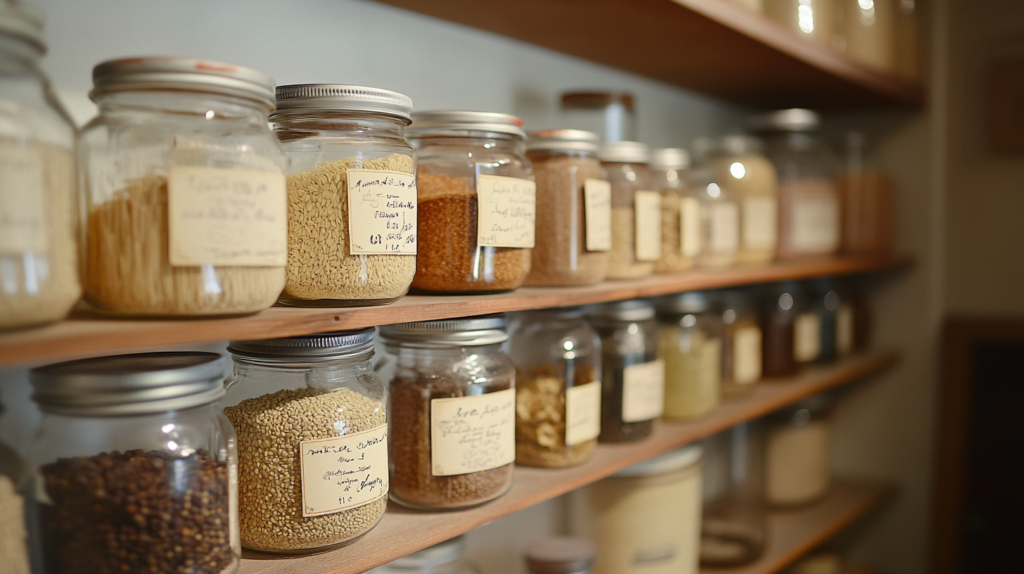
Stocking your pantry with the right staples is one of the smartest ways to save money and reduce food waste. A well-planned pantry ensures you always have the essentials for quick, affordable meals, avoiding unnecessary takeout or grocery trips. In this guide, we’ll show you how to create a pantry staples list that supports your budget and keeps your kitchen ready for anything.
1. Why Pantry Staples Are Essential
Key Benefits:
- Saves Money: Buying staples in bulk is often cheaper per unit.
- Convenience: Reduces the need for last-minute grocery runs.
- Versatility: Enables you to prepare a variety of meals with minimal effort.
2. Building Your Pantry Staples List
Start by focusing on items with a long shelf life and multiple uses. Here are some categories to include:
Grains and Carbs
- Rice (white, brown, or basmati)
- Pasta (spaghetti, penne, or noodles)
- Oats (instant or rolled)
- Flour (all-purpose, whole wheat, or gluten-free)
Proteins
- Canned beans (black, kidney, or chickpeas)
- Lentils (dried or canned)
- Canned tuna or salmon
- Peanut butter or other nut butters
Canned and Jarred Goods
- Diced tomatoes
- Tomato paste or sauce
- Coconut milk
- Broth (chicken, beef, or vegetable)
Spices and Seasonings
- Salt and pepper
- Garlic and onion powder
- Paprika, cumin, and chili powder
- Dried herbs like oregano, thyme, and basil
Oils and Condiments
- Olive oil or vegetable oil
- Vinegar (white, apple cider, or balsamic)
- Soy sauce
- Honey or maple syrup
Baking Essentials
- Baking powder and baking soda
- Sugar (white, brown, or powdered)
- Yeast (for bread-making)
- Vanilla extract
Snacks and Extras
- Nuts and seeds
- Crackers or rice cakes
- Dried fruits
- Popcorn kernels
3. Tips for Stocking Your Pantry on a Budget
1. Buy in Bulk
- Look for bulk bins or wholesale stores to save money on grains, spices, and dried goods.
- Store bulk items in airtight containers to keep them fresh.
2. Watch for Sales
- Stock up on non-perishable items during sales or promotions.
- Use apps like Flipp to track weekly deals.
3. Prioritize Versatile Items
- Choose ingredients that work in multiple recipes, such as rice (for stir-fries, soups, or casseroles) or canned tomatoes (for sauces, stews, and curries).
4. Rotate Stock
- Follow the “first in, first out” rule: use older items before newer ones to avoid waste.
- Check expiration dates regularly and organize your pantry accordingly.
4. Meal Ideas Using Pantry Staples
Having a stocked pantry means you’re never far from a delicious, budget-friendly meal. Here are a few ideas:
- Vegetarian Chili: Combine canned beans, diced tomatoes, and spices for a hearty meal.
- Pasta Primavera: Toss pasta with olive oil, garlic, and any fresh or frozen vegetables.
- Rice and Beans: A simple, protein-packed dish with endless seasoning options.
- Tomato Soup: Blend canned tomatoes with broth and seasonings for a comforting bowl.
5. Common Pantry Mistakes to Avoid
1. Buying Too Much
Overstocking can lead to waste if items expire before you use them. Stick to quantities you can realistically consume.
2. Ignoring Spices
Using fresh spices transforms basic staples into flavorful meals, so don’t neglect this category.
3. Forgetting Perishables
While pantry staples are essential, pairing them with fresh produce or proteins creates more balanced meals.
6. Keep It Organized
An organized pantry saves time and ensures you can see what you have at a glance.
- Use clear containers for grains, flours, and snacks.
- Label jars and bins to avoid confusion.
- Group similar items together, such as spices or canned goods.
Practical Takeaway
Creating and maintaining a pantry staples list is a game-changer for your budget and meal planning. With the right essentials on hand, you’ll save money, reduce waste, and always have the ingredients for a home-cooked meal. Start building your pantry today, and watch your grocery costs drop while your meal options expand.
